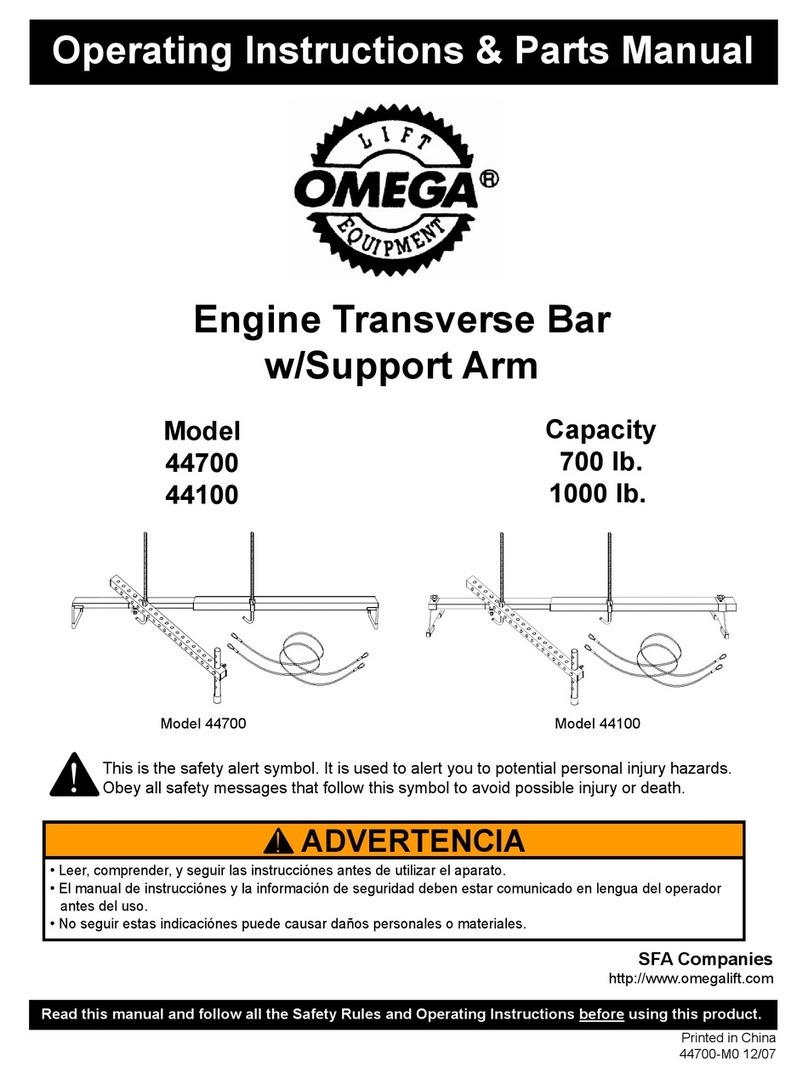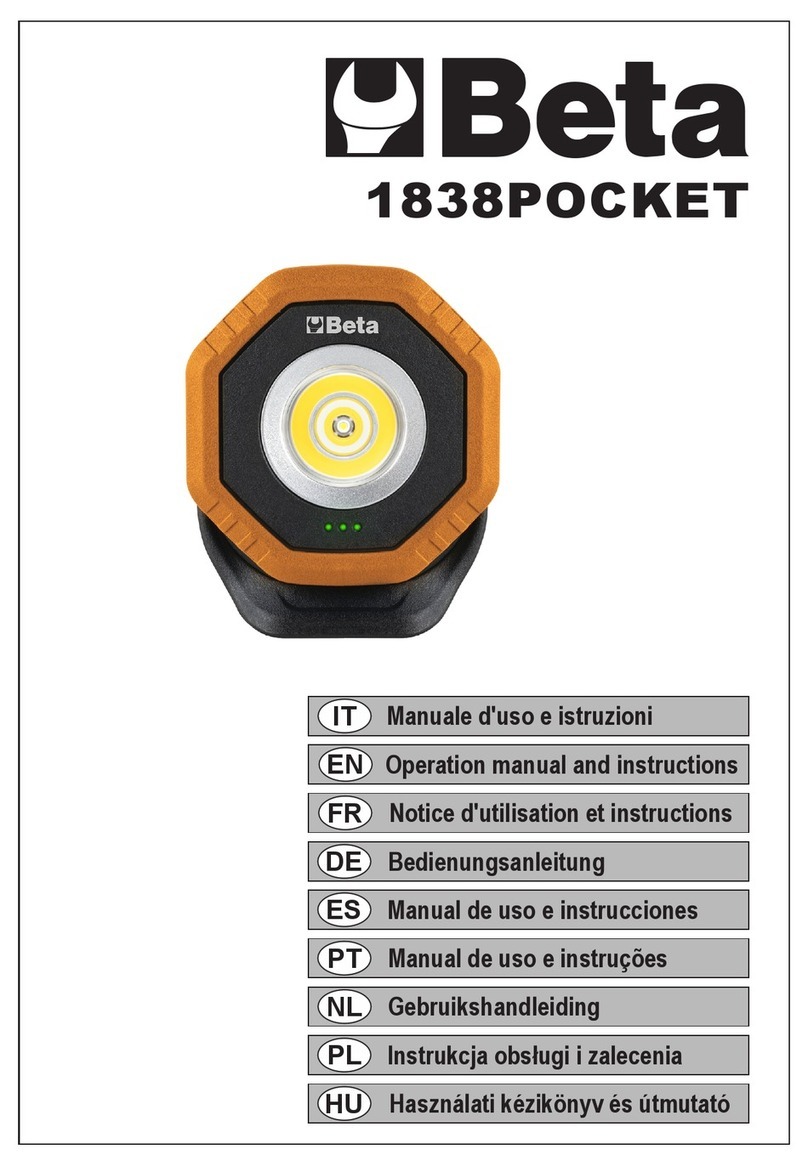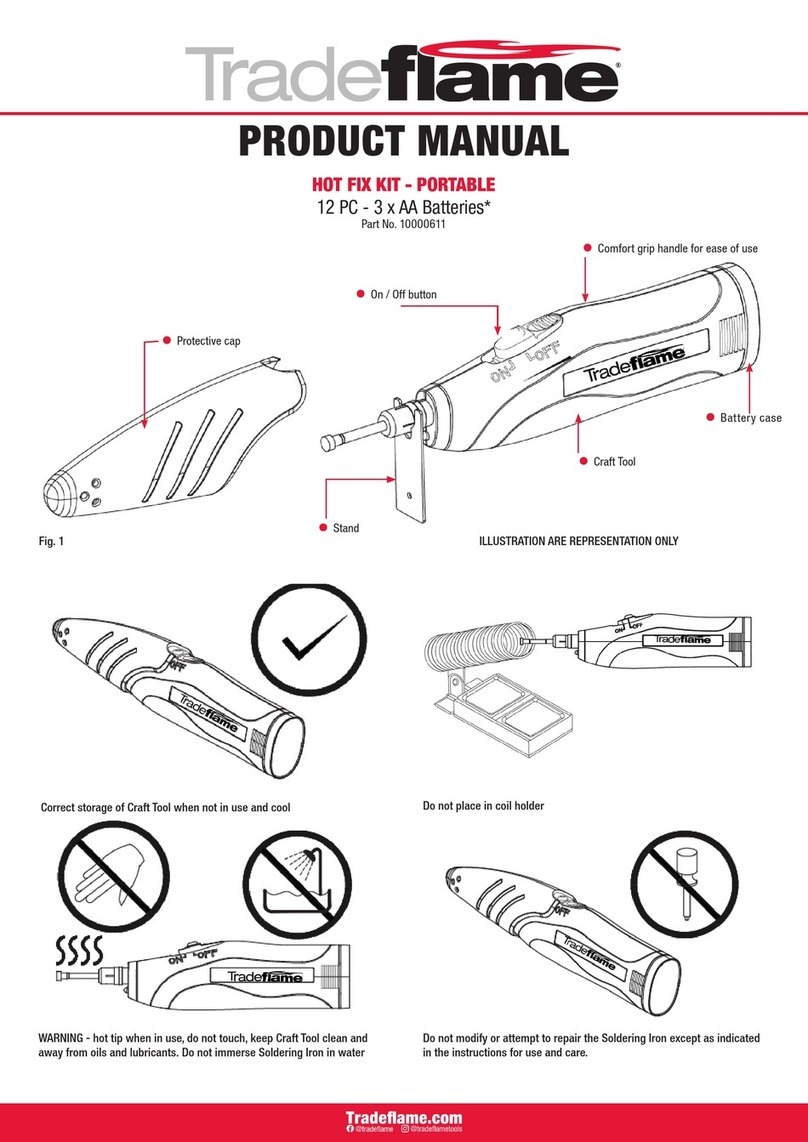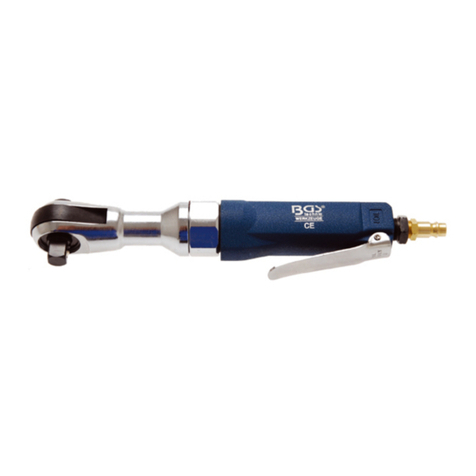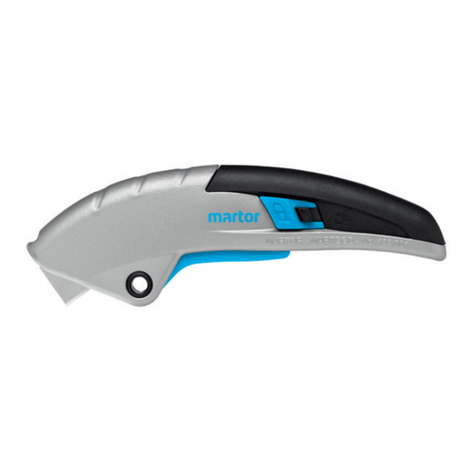ToolMaster ATP-50 User manual

1
www.machineryhouse.com.au
www.machineryhouse.co.nz
Industrial Series
AiR PUNCH & FLANGE TOOL
INSTRUCTION MANUAL
Code: A088
www.machineryhouse.com.au www.machineryhouse.co.nz
ATP-50

2
www.machineryhouse.com.au
www.machineryhouse.co.nz
1. Read and understand this entire manual before
attempting assembly or operation.
2. Read and understand all warnings posted on
the tool and in this manual. Failure to comply
with all of these warnings may cause serious
injury.
3. Replace warning labels if they become
obscured or removed.
4. Do not use this tool for other than its intended
use. If used for other purposes, Toolmaster
disclaims any real or implied warranty and
holds itself harmless from any injury that may
result from that use.
5. Always wear approved safety glasses or face
shield while using this tool. (Everyday eye
glasses only have impact resistant lenses; they
are not safety glasses.)
6. Wear ear protectors (plugs or muffs) if the
noise exceeds safe levels.
7. Wear gloves and protective clothing if
operationproducessparksoryingparticles.
Glovesshouldbetight-tting,withoutfrayed
ngersorhangingthreads.Keephandsand
body away from the working area of tool.
8. Do not operate an air tool continually at full
throttle without a work load on the tool.
9. The air tool must be properly lubricated
before operating.
10. Never start a percussion type air tool (chipper,
breaker, buster, etc.) without securing the
tooling in the retainer and placing the tip
against the work surface.
11. Do not operate air tool without its guards in
place. Do not modify the tool.
12. Do not operate this tool while tired or under the
inuenceofdrugs,alcohol,oranymedication.
13. Adopt a comfortable posture with proper
balance,and maintain secure footing at all
times.Non-slipfootwearoranti-skidoorstrips
are recommended.
14.Donotwearlooseclothingorjewellery.Conne
long hair.
15. Excessive air pressure and too much free
rotation may decrease life of the tool and may
cause a hazardous situation.
16. Check air hoses for wear, and keep them away
from heat and sharp edges. Repair or replace
damaged air hose immediately. Do not carry
tool by the air hose.
17. Air hose may cause tripping hazards; keep hose
awayfromtrafcareas.
18.Donotusethistoolnearammableobjects,or
in potentially explosive environments. Do not
use near live electrical wires.
19. Do not use power tools in damp or wet location,
orexposethemtorain.Keepworkareawell
lighted.
20. Do not leave a connected tool unattended.
When not in use, disconnect tool from air
source.
21. Shut off air supply and discharge any residual
pressure from tool before removing hose,
making adjustments, changing accessories, or
storing tool.
22.Makesuretoolisswitchedoff,andyournger
off the trigger, before connecting to air supply.
Remove adjusting keys before operating
24.Keepvisitorsasafedistancefromthework
area.Keepchildrenaway.
Safety Air Tool Warnings

3
www.machineryhouse.com.au
www.machineryhouse.co.nz
Safety Specic For Punch & Flange Tool
Warning: Some dust, fumes and gases created by power sanding, sawing, grinding,
drilling, welding and other construction activities contain chemicals that may cause cancer and birth
defects or other reproductive harm. Some examples of these chemicals are:
• lead from lead based paint
• crystalline silica from bricks, cement and other masonry products
• arsenic and chromium from chemically treated timber
Your risk of exposure varies, depending on how often you do this type of work. To reduce your
exposure to these chemicals, work in a well-ventilated area and work with approved safety
equipment, such as dust masks that are specically designed to lter out microscopic particles
1. Donottrytopunchorangematerialthicker
thancapacityspeciedinthespecication
2. Appropriate footwear must be worn. Shoes
must be fully enclosed. No open-toed shoes.
3. Put on all required personal protective
equipment and proper eye protection must be
worn at all times by tool user and bystanders
4. Use this tool with both hands only. Using tools
with only one hand can result in loss of control
5. Always remove the tool from air supply and
activate trigger to bleed air-line before making
any adjustments, changing accessories, or
doing any maintenance or service on the tool
6. It must be understood by the operator that
common sense and caution are factors which
cannot be built into this product, but must be
supplied by the operator
Punching Capacity (Mild Steel) 1.2mm
Flange Capacity (Mild Steel) 14 Gauge
Punch Diameter 5mm
Air Requirements 4CFM (1131/min)
Maximum Air Pressure 90 PSI
Recommended Air Hose 10mm
Inlet 1/4” BSPT
Sound Pressure 85.5dBA
Length 250mm
Weight 1.9kg
Technical Specications

4
www.machineryhouse.com.au
www.machineryhouse.co.nz
Any missing parts or damage should be reported immediately to your Toolmaster distributor. Do not use
a damaged tool. Read this instruction manual thoroughly for operation, maintenance and safety
instructions. The diagram below is the ideal setup position. The lubricator is optional and if not used, then
a few drops of Pneumatic Tool Oil need to be added to the airline connection before operation. Add a few
more drops after each hour of continual use.
WARNING: Operating the tool at pressures over the rated capacity may cause severe
damage and/or personal injury. Do not exceed 90 PSI while operating the tool. Do not
use an accessory rated at a lower maximum pressure than the tool.
C
ompressor
A
ir
H
ose
F
ilter
r
egulAtor
l
ubriCAtor
A
ir
H
ose
C
oupler
& F
itting
t
ool
Fig. 1
Setup
The recommended air system is shown in Fig.1.
1. Useproperairhosesize(refertotoolspecications).Thehoseshouldbejustlongenoughto
serve the working area. Excessive hose length will cause pressure drop.
WARNING! Ensure that the air supply is clean and does not exceed 90psi. Too high an air
pressure and/or unclean air will shorten the life of the air tool due to accelerated wear,
and may cause damage and/or personal injury.
2. Drain the compressor air tank daily. Water in the air line will damage the air tool.
3. Cleanthecompressorairinletlterscreenweekly.
4. Line pressure should be increased to compensate for unusually long air hoses (over 8 meters).
Theminimumhoseboreshouldbe10mmandttingsmusthavethesameinsidedimensions.
5. Keephosesawayfromheat,oilandsharpedges.Checkhosesforwear,andmakecertainthatall
connections are secure.
IMPORTANT: The leader hose is optional, but connecting a quick-change coupling directly to the
tool is not recommended, as vibration may cause the connection to fail. For the best result, add a
leader hose and install any quick-change couplings farther down the line.
Air Supply
l
eAder
H
ose

5
www.machineryhouse.com.au
www.machineryhouse.co.nz
1. Disconnect the air tool from the air line.
2. If required, to improve access to the workpiece, the head can be rotated through 360°. To do this,
loosen the Head Rotation lock screw and rotate the head. (See Fig.2)
3. If an automatic oiler is not used, add a few drops of Pneumatic Tool Oil to the airline connection
before use. Add a few drops more after each hour of continual use.
4. Make sure the material to be worked does not exceed the capacity for this Air Punch and Flange
tool: 1.2mm for sheet steel.
5. Ensure that the workpiece is marked out and secure.
6. Connect the air line to the tool.
7. Select to use either the Punch or Flange operation. (See Fig. 2)
To Punch: Insert the edge of the workpiece between the Punch Die and the Punch. Make sure your
marks are aligned with the Punch Die.
Squeeze the Throttle Lever and the Punch will pierce the workpiece.
To Flange: Insert the workpiece into the Flanging Jaw between the Anvil and the Clamp. Push the
workpiece all the way in until it is hard up against the back of both the Anvil and the Clamp.
Squeezethethrottleleverandtheanvilwillbedrivenagainsttheclampformingaange.
(See Fig. 3)
8. Ifthetoolrequiresmoreforcetoaccomplishthetask,verifythatthetoolreceivessufcient,
unobstructedairow(CFM)andincreasethepressure(PSI)outputoftheregulatoruptothe
maximum air pressure rating of this tool.
CAUTION! TO PREVENT INJURY FROM TOOL OR ACCESSORY FAILURE:
Do not exceed the tool’s maximum air pressure rating. If the tool still does not have
sufcient force at maximum pressure and sufcient airow, then a larger tool may be
required.
9. To prevent accidents, turn off the tool, detach the air supply, safely discharge any residual air
pressure in the tool, and release the throttle and/or turn the switch to its off position after use. Clean
external surfaces of the tool with clean, dry cloth, and apply a thin coat of tool oil, then store the
tool indoors out of children’s reach.
WARNING: After disconnecting the Air Punch/Flange Tool from the air supply there could still be
enoughairpressuretorethePunch/Flange.Aftermakingsuretheairsupplyisdisconnected,
ALWAYSrethePunch/Flangerepeatedlytomakesureallairisbledfromthetool.
Operating Instructions
Fig. 2
FlAnge JAw
operAting trigger Air inlet
HeAd rotAtion
sCrew
punCH
Fig. 3

6
www.machineryhouse.com.au
www.machineryhouse.co.nz
1. Daily - Air Supply Maintenance:
Every day, maintain the air supply according to the component manufacturers’ instructions.
Maintain the lubricator’s oil level. Use Pneumatic Tool Oil (Order Code A037)
Drainthemoisturelterregularly.
Performing routine air supply maintenance will allow the tool to operate more safely and will also
reduce wear on the tool.
2. Quarterly (every 3 months) – Tool Disassembly, Cleaning, and Inspection:
Havetheinternalmechanismcleaned,inspected,andlubricatedbyaqualiedtechnician.
3. For a full service contact your local Toolmaster service agent.
4. When not in use, disconnect from air supply, clean nibbler and store in a safe and dry place.
Maintenance
Symptoms Possible Cause Possible Solution
Decreased output.
1.Notenoughairpressureand/orairow.
2. Obstructed throttle.
3. Incorrect lubrication or not enough
lubrication.
4. Blocked air inlet screen (if equipped).
5. Air leaking from loose housing.
6. Mechanism contaminated.
7. Vane wear or damage.
1. Check for loose connections and make sure
thatairsupplyisprovidingenoughairow
(CFM) at required pressure (PSI) to the tool’s air
inlet. Do not exceed maximum air pressure.
2. Clean around throttle to ensure free movement.
3. Lubricate using air tool oil and grease according
to directions.
4. Clean air inlet screen of buildup.
5. Make sure housing is properly assembled and
tight.
6.Havequaliedtechniciancleanandlubricate
mechanism.Installin-linelterinairsupplyas
stated in Setup: Air Supply.
7. Replace all vanes.
Housing heats
during use
1. Incorrect lubrication or not enough
lubrication.
2. Worn parts.
1. Lubricate using air tool oil and grease according
to directions.
2.Havequaliedtechnicianinspectinternal
mechanism and replace parts as needed.
Severe air leakage
(Slight air leakage
is normal,
especially on older
tools.
1. Cross-threaded housing components.
2. Loose housing.
3. Damaged valve or housing.
4. Dirty, worn or damaged valve.
1. Check for incorrect alignment and uneven gaps.
If cross-threaded, disassemble and replace
damaged parts before use
2. Tighten housing assembly. If housing cannot
tighten properly, internal parts may be
misaligned
3. Replace damaged components.
4. Clean or replace valve assembly.
Review the troubleshooting and procedures in this section if a problem develops with your Air Tool.
If you are still unable to resolve the problem, then contact your local Toolmaster service centre. If
additional help with a procedure is required, then contact you distributor.
Note: Make sure you have the model of the machine, serial number,and manufacture date
before calling.
Troubleshooting
INDUSTRIAL AIR TOOLS
Table of contents
Popular Tools manuals by other brands
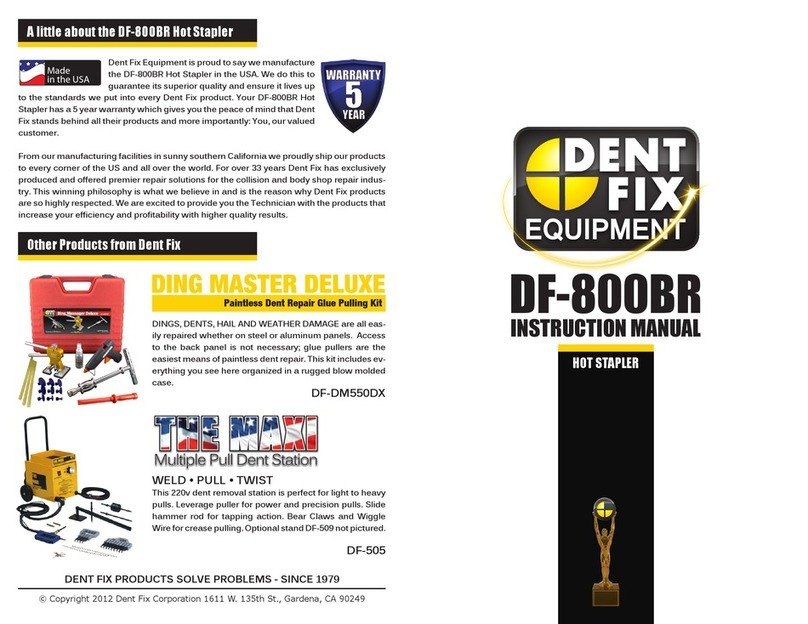
Dent Fix Equipment
Dent Fix Equipment DF-800BR instruction manual
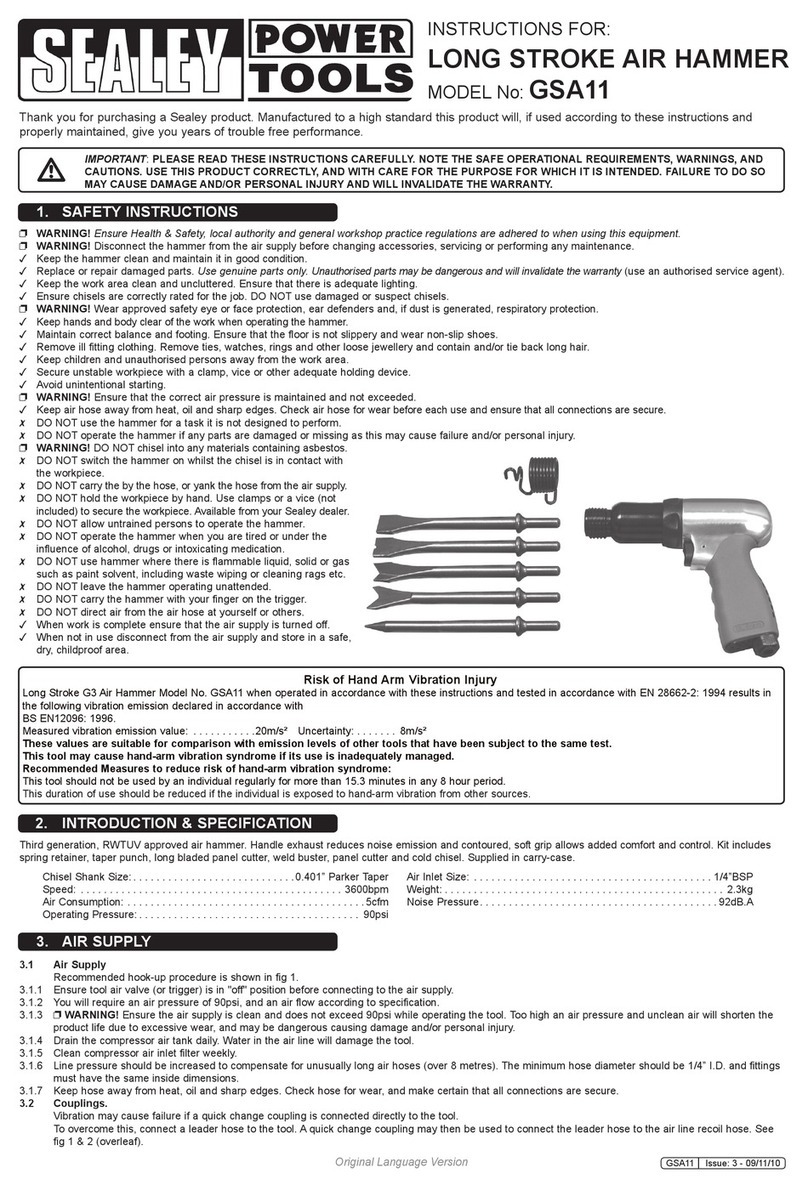
Sealey
Sealey Power tools GSA11 instructions
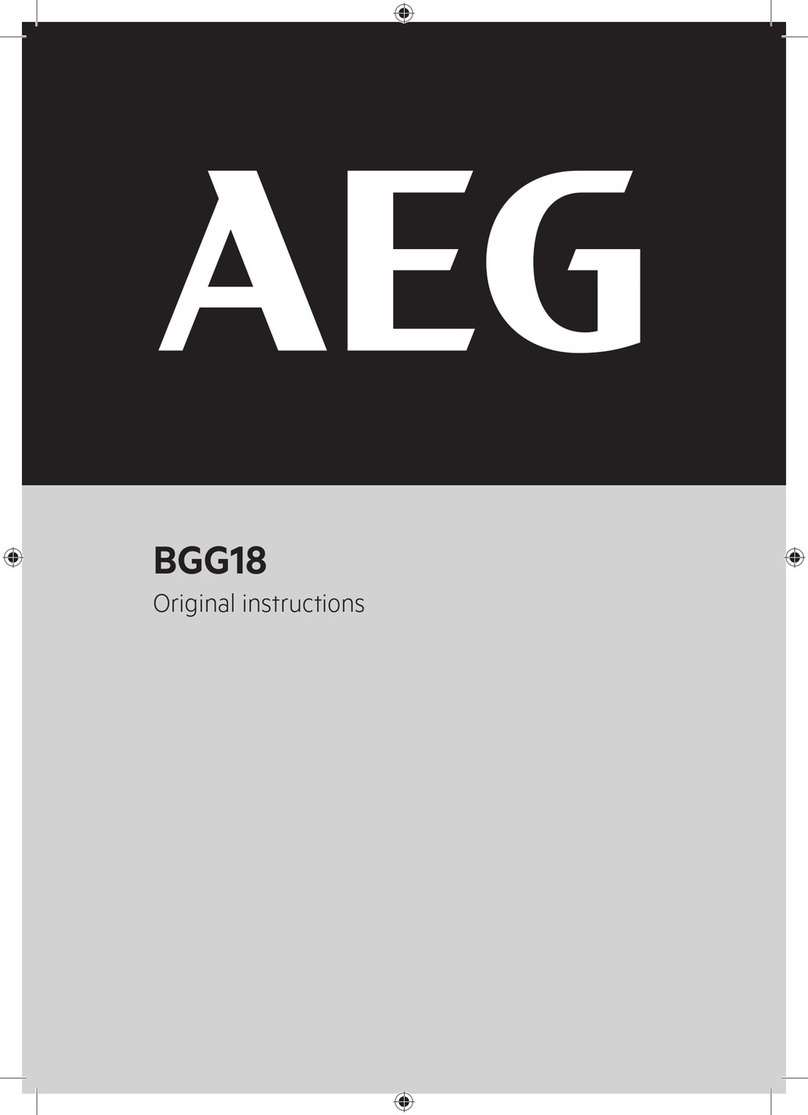
AEG
AEG BGG18 Original instructions

ROKAMAT
ROKAMAT PFM WT Original instructions
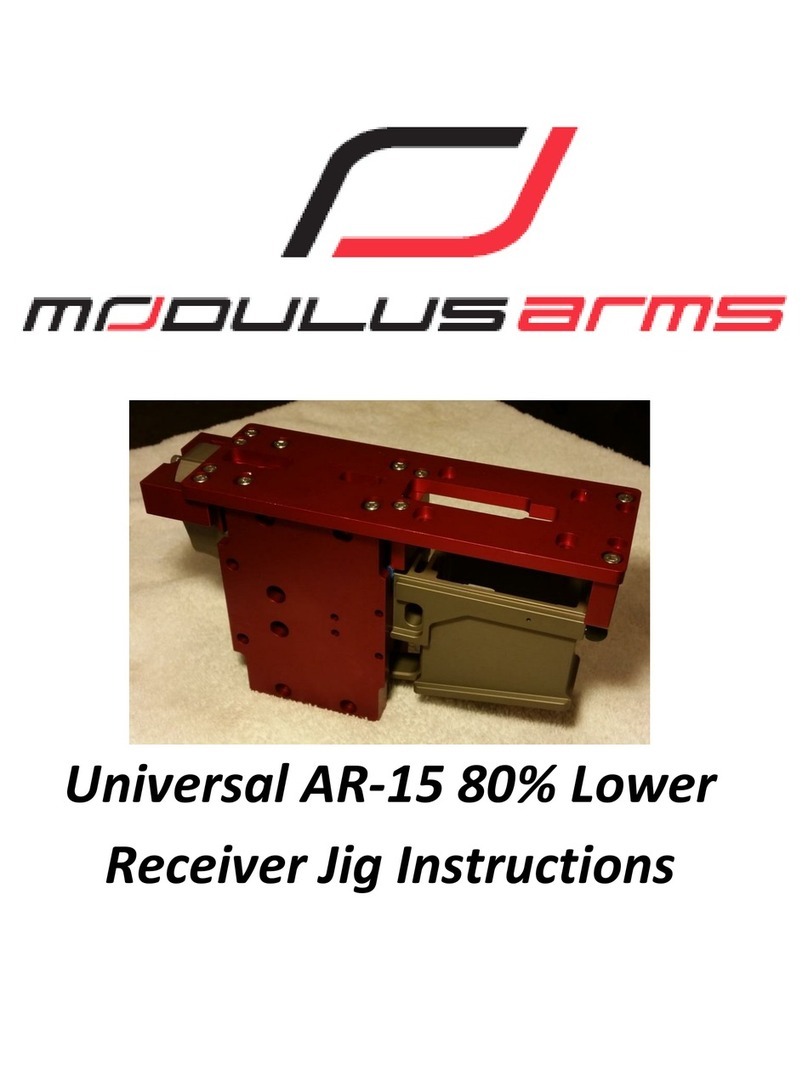
Modulus Arms
Modulus Arms AR-15 instructions

Ingersoll-Rand
Ingersoll-Rand C225H Parts, operation and maintenance manual

Southwire
Southwire XTS-01 operating instructions
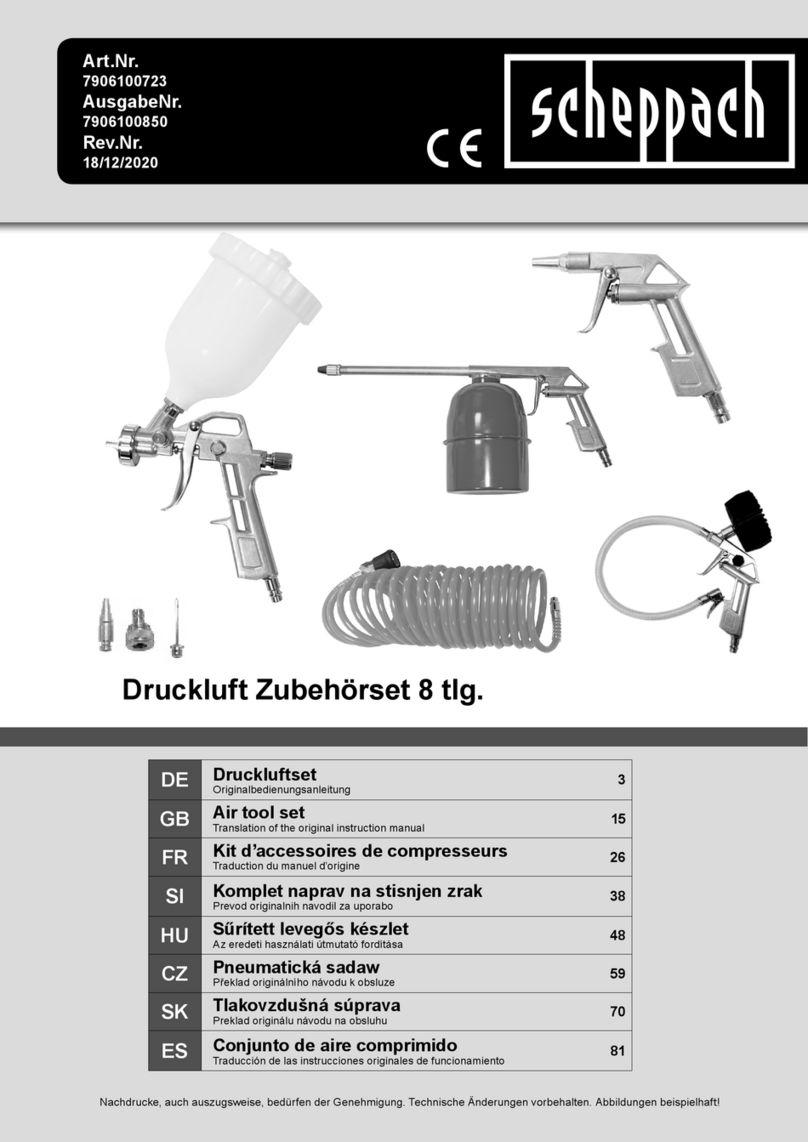
Scheppach
Scheppach 7906100723 Translation of the original instruction manual

Makita
Makita DG002G instruction manual
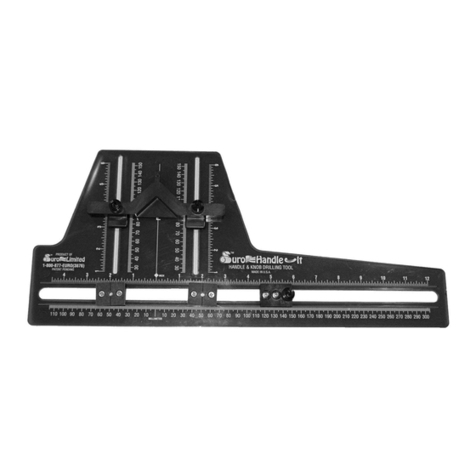
EURO Limited
EURO Limited Handle-It Tool manual
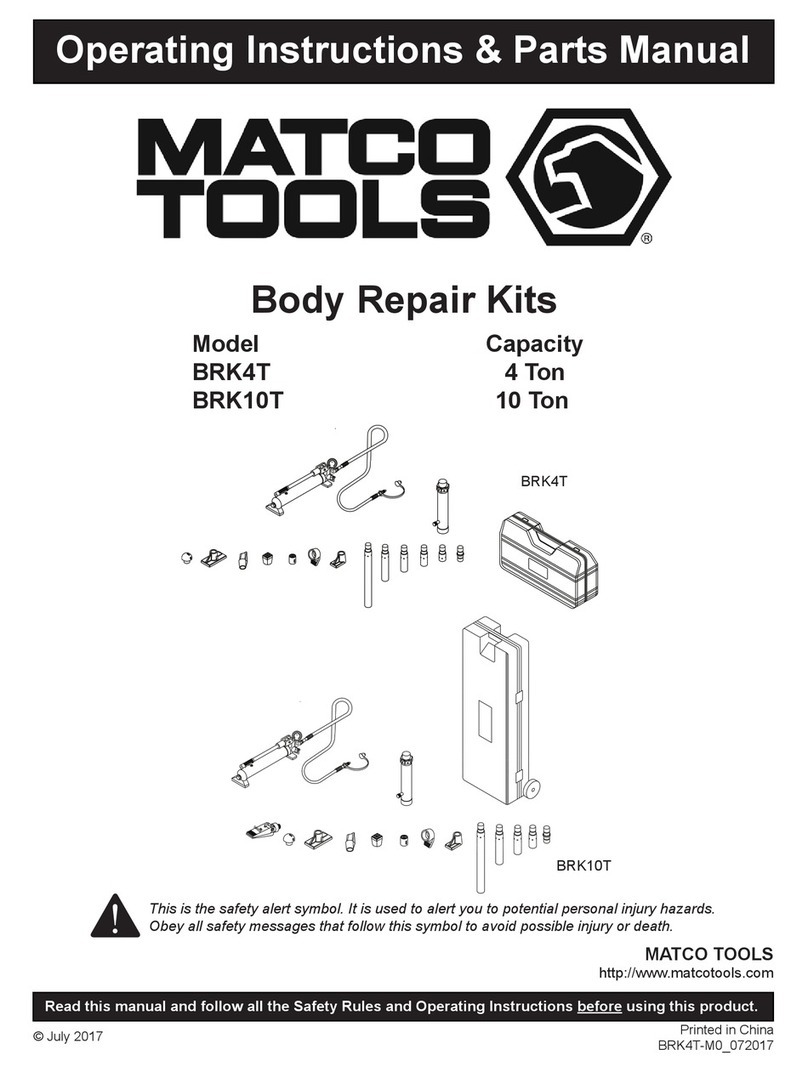
Matco Tools
Matco Tools BRK10T Operating instructions & parts manual
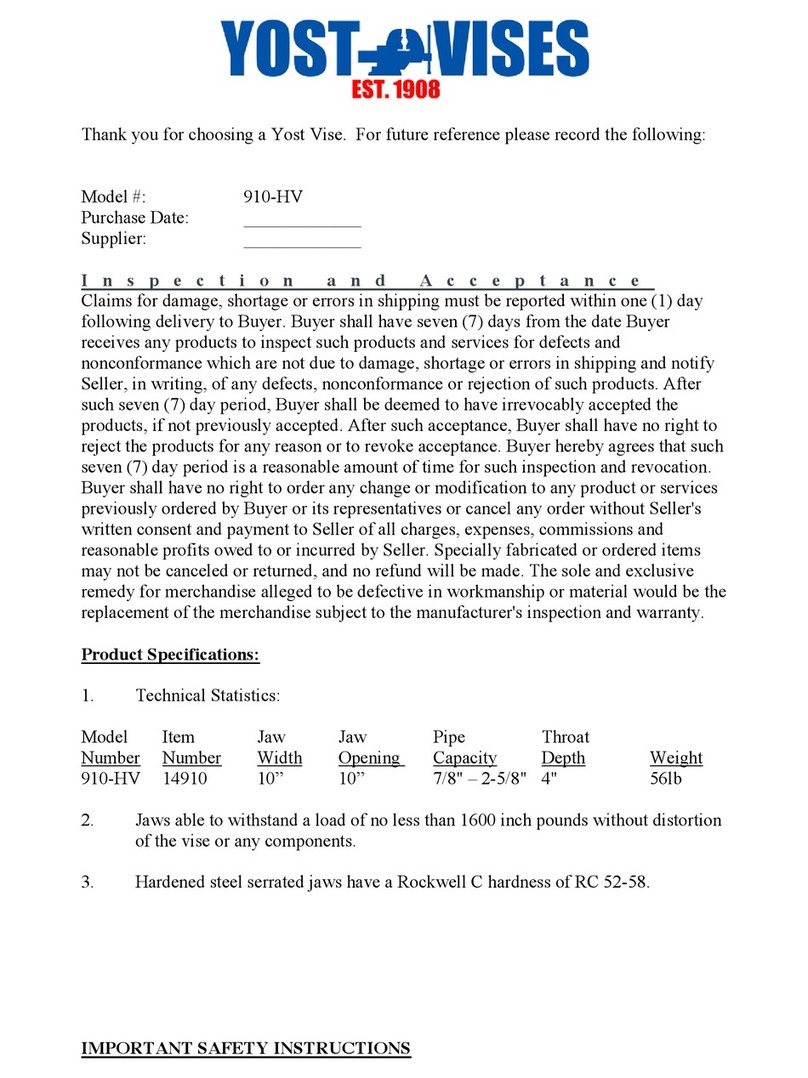
Yost Vise
Yost Vise 910-HV manual
